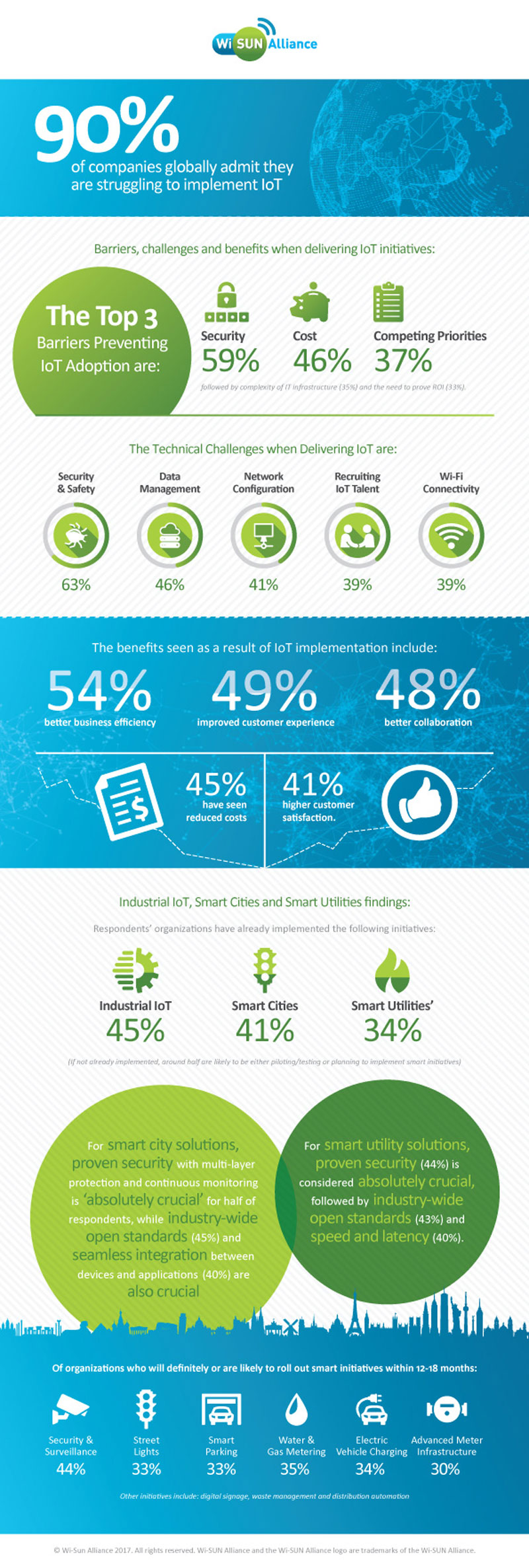The struggles of implementing IoT into businesses
A new report from Wi-SUN Alliance, has shown that half of organisations investing in IoT initiatives already have a fully implemented strategy in place, while more than a third (36%) have a partially implemented strategy. Companies are most advanced in the oil and gas industry, with 75% having a fully implemented strategy, followed by Technology (59%) and Energy and Utilities (57%).
A survey of 350 IT decision makers in the UK, US, Sweden and Denmark examining attitudes to IoT, including the drivers, barriers, challenges and benefits, the research highlights the growing number of smart utilities, smart cities and broader IoT projects in progress.
While respondents report that enabling IoT is the second most important IT priority for the next 12 months, just behind improving security, almost all (90%) of those with an IoT plan at various stages of implementation have struggled to implement this, with over a third (36%) saying they find it 'very or extremely difficult'.
When it comes to the key drivers for IoT implementation, around half (47%) of those surveyed report it will improve ‘network intelligence and connectivity for citizen safety and quality of life’, followed by ‘creating business efficiencies’ (42%) and ‘improving reliability of systems and services’ (41%).
Two-thirds of respondents’ organisations with an IoT strategy report that it covers how IoT can be used to improve the customer experience, while six in ten say it includes a plan for continuous IoT improvement.
Benefits, barriers, and challenges when delivering IoT initiatives:
- 99% have enjoyed benefits as a result of IoT implementations, including better business efficiency (54%), an improved customer experience (49%) and better collaboration (48%). Additional benefits include reduced costs (45%) and faster time to market (40%).
- Respondents highlight security as a barrier to IoT adoption. 59% of them cite security concerns, with the US (65%) and UK (64%) far more concerned than those in Denmark or Sweden. Nearly a third (32%) see funding, as well as a lack of commitment from leadership, as barriers, while 30% view leadership’s lack of understanding of the benefits of IoT as a challenge.
- The technical challenges when delivering IoT are security and safety (63%), data management (46%), network configuration (41%), recruiting IoT talent (39%) and WiFi connectivity (39%).
When asked what their organisation looks for when evaluating IoT technologies, 58% of respondents look for network topology and coverage, followed by communications performance in terms of latency, bandwidth and bi-directional communication (53%). Other characteristics include support for industry standards (52%), while standardisation is also important when it comes to choosing IoT in specific applications - 45% of respondents demand that smart city IoT solutions be built using industry-wide open standards, while 43% say it is absolutely crucial in a smart utilities.
As for network technologies, respondents are most likely to be familiar with Wi-SUN (56%), SigFox (49%), or NB-IoT (45%).
“While all organisations taking part had IoT initiatives underway, it’s very encouraging to see that over half have an IoT strategy fully implemented, with the vast majority of those in sectors you’d most closely associate with smart city and smart utility initiatives, such as Energy and Utilities, as well as Oil and Gas companies,” according to Phil Beecher, President and CEO, Wi-SUN Alliance. “It’s also encouraging to see Wi-SUN supported by so many products and solutions out there and leading the pack in terms of networking technologies.
“However, there’s a lot of education still to be done for those looking to implement IoT, smart cities and other IoT initiatives, especially when selecting the right technology. For example, there are some fundamental advantages of Wi-SUN, including support for higher data rates delivering lower latency, mesh network configuration, increasing network resilience - and importantly, extremely robust security. Our advice for those developing, designing or procuring IoT, now or in the future, is to look closely at the reliability they need, the latency, and the security - and to make sure that these match up with the needs and goals of the organisation.”











